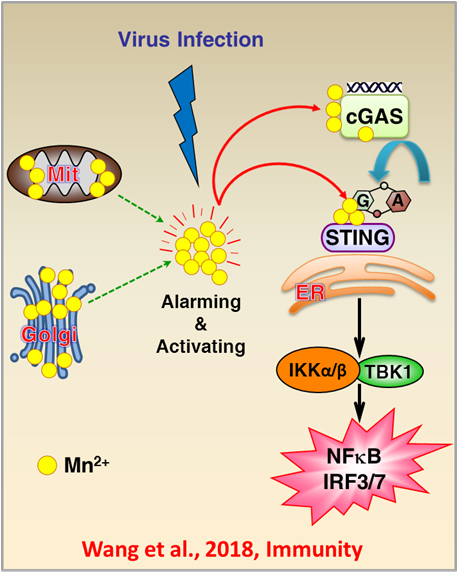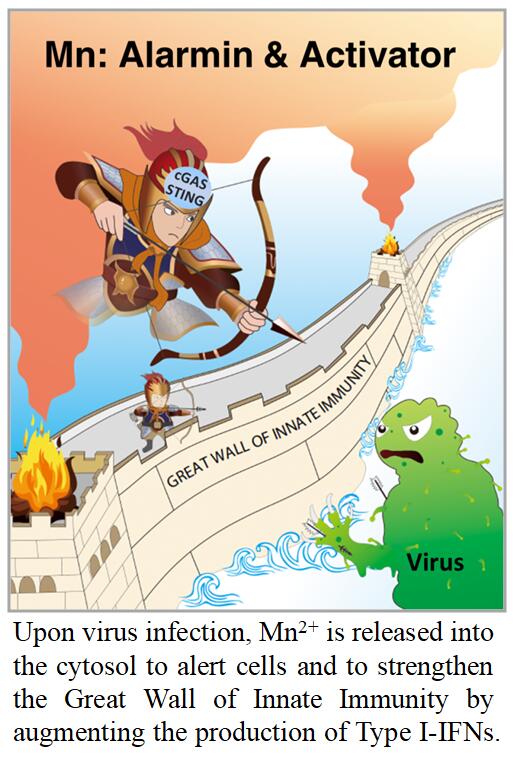Innate immune cells speak Manganese
Source:Zhengfan Jiang
2018-05-02
On April 17th, Prof. Zhengfan Jiang (School of Life Sciences, Peking University) has published a paper in Immunity about the novel role of Manganese (Mn) in innate immune activation and host defense (Wang, C. and Guan, Y., et al. (2018) Manganese Increases the Sensitivity of the cGAS-STING Pathway for Double-stranded DNA and Is Required for the Host Defense against DNA Viruses. Immunity 48, 675-687)
Viral infection triggers host innate immune responses that result in the production of various cytokines including type I interferons (IFN). For cytoplasmic DNA sensing, it has been discovered that cGAS recognizes cytosolic DNA and produces cGAMP, which functions as a second messenger to activate STING, and triggers the activation of transcription factors NF-κB and IRF-3 or IRF-7 and the production of type I-IFNs.

In this paper, Prof. Jiang’s group identified a role of Mn2+ in alerting cells to viral infection via sensitizing both cGAS and STING. Mn2+ was liberated from membrane-enclosed organelles including mitochondria and the Golgi apparatus and accumulated in the cytosol, and bound to cGAS by increasing both the dsDNA sensitivity and the enzymatic activity of cGAS. Mn2+ also promoted STING's activity through the enhanced cGAMP-STING binding affinity. The liberated cytosolic Mn2+ thus lowered the detection limit of host cells to dsDNA and virus by several orders of magnitude. Importantly, Mn-deficient mice produced decreased amounts of cytokines and were more vulnerable to DNA viruses as Sting-deficient (Tmem173−⁄−) mice did. Mn-deficient Tmem173−⁄− mice displayed no further increased susceptibility to virus compared with Mn-sufficient Tmem173−⁄− mice. Reconstitution of cellular Mn in Mn-deficient cells effectively restored their responses to DNA viruses. In addition, Mn2+ itself was a potent innate immune stimulator, inducing a strong type I-IFN response and cytokine production in the absence of any infection. These results thus demonstrated that Mn is critically involved and required for the host defense against virus and thus for the first time demonstrate that a trace element is used by host cells as an alarmin or danger signal during virus infection.

Mn2+ is very similar to Mg2+ in terms of the chemical properties. Previous work showed that Mn2+ is able to replace Mg2+ in vitro in almost half of Mg2+-dependent enzymes, in which the catalytic activity of the enzymes are often maintained. In this study, however, Mn2+ not only replaces Mg2+ in cGAS activation, but also enhances its enzymatic activity and ligand sensitivity. Moreover, an Immunity Preview paper titled “Innate Immune Cells Speak Manganese” by Prof. Hajo at Berlin Institute of Technology considered Mn2+ as a new “second messenger” due to its function in innate immune activation reported in this work. Further, Dr. Hajo thought that the physical and chemical properties of Mn make it an eligible candidate as the second messenger and that other unidentified signaling functions for Mn2+ are waiting to be discovered.
Ph.D. student Chenguang Wang and Dr. Yukun Guan from Peking University are the co-first authors of this paper. Prof. Zhengfan Jiang is the corresponding author. Profs. Xiaodong Su (School of Life Sciences, Peking University) Yi Wan (College of Urban and Environmental Sciences, Peking University) and Xiaojun Huang (Peking University People's Hospital) participate in the study. This work was supported by grants from the Natural Science Foundation of China, National Program on Key Basic Research Project (973 Program) and Peking-Tsinghua Center for Life Sciences.
Full Text Link: https://www.cell.com/immunity/fulltext/S1074-7613(18)30093-1
Viral infection triggers host innate immune responses that result in the production of various cytokines including type I interferons (IFN). For cytoplasmic DNA sensing, it has been discovered that cGAS recognizes cytosolic DNA and produces cGAMP, which functions as a second messenger to activate STING, and triggers the activation of transcription factors NF-κB and IRF-3 or IRF-7 and the production of type I-IFNs.

In this paper, Prof. Jiang’s group identified a role of Mn2+ in alerting cells to viral infection via sensitizing both cGAS and STING. Mn2+ was liberated from membrane-enclosed organelles including mitochondria and the Golgi apparatus and accumulated in the cytosol, and bound to cGAS by increasing both the dsDNA sensitivity and the enzymatic activity of cGAS. Mn2+ also promoted STING's activity through the enhanced cGAMP-STING binding affinity. The liberated cytosolic Mn2+ thus lowered the detection limit of host cells to dsDNA and virus by several orders of magnitude. Importantly, Mn-deficient mice produced decreased amounts of cytokines and were more vulnerable to DNA viruses as Sting-deficient (Tmem173−⁄−) mice did. Mn-deficient Tmem173−⁄− mice displayed no further increased susceptibility to virus compared with Mn-sufficient Tmem173−⁄− mice. Reconstitution of cellular Mn in Mn-deficient cells effectively restored their responses to DNA viruses. In addition, Mn2+ itself was a potent innate immune stimulator, inducing a strong type I-IFN response and cytokine production in the absence of any infection. These results thus demonstrated that Mn is critically involved and required for the host defense against virus and thus for the first time demonstrate that a trace element is used by host cells as an alarmin or danger signal during virus infection.

Ph.D. student Chenguang Wang and Dr. Yukun Guan from Peking University are the co-first authors of this paper. Prof. Zhengfan Jiang is the corresponding author. Profs. Xiaodong Su (School of Life Sciences, Peking University) Yi Wan (College of Urban and Environmental Sciences, Peking University) and Xiaojun Huang (Peking University People's Hospital) participate in the study. This work was supported by grants from the Natural Science Foundation of China, National Program on Key Basic Research Project (973 Program) and Peking-Tsinghua Center for Life Sciences.
Full Text Link: https://www.cell.com/immunity/fulltext/S1074-7613(18)30093-1


